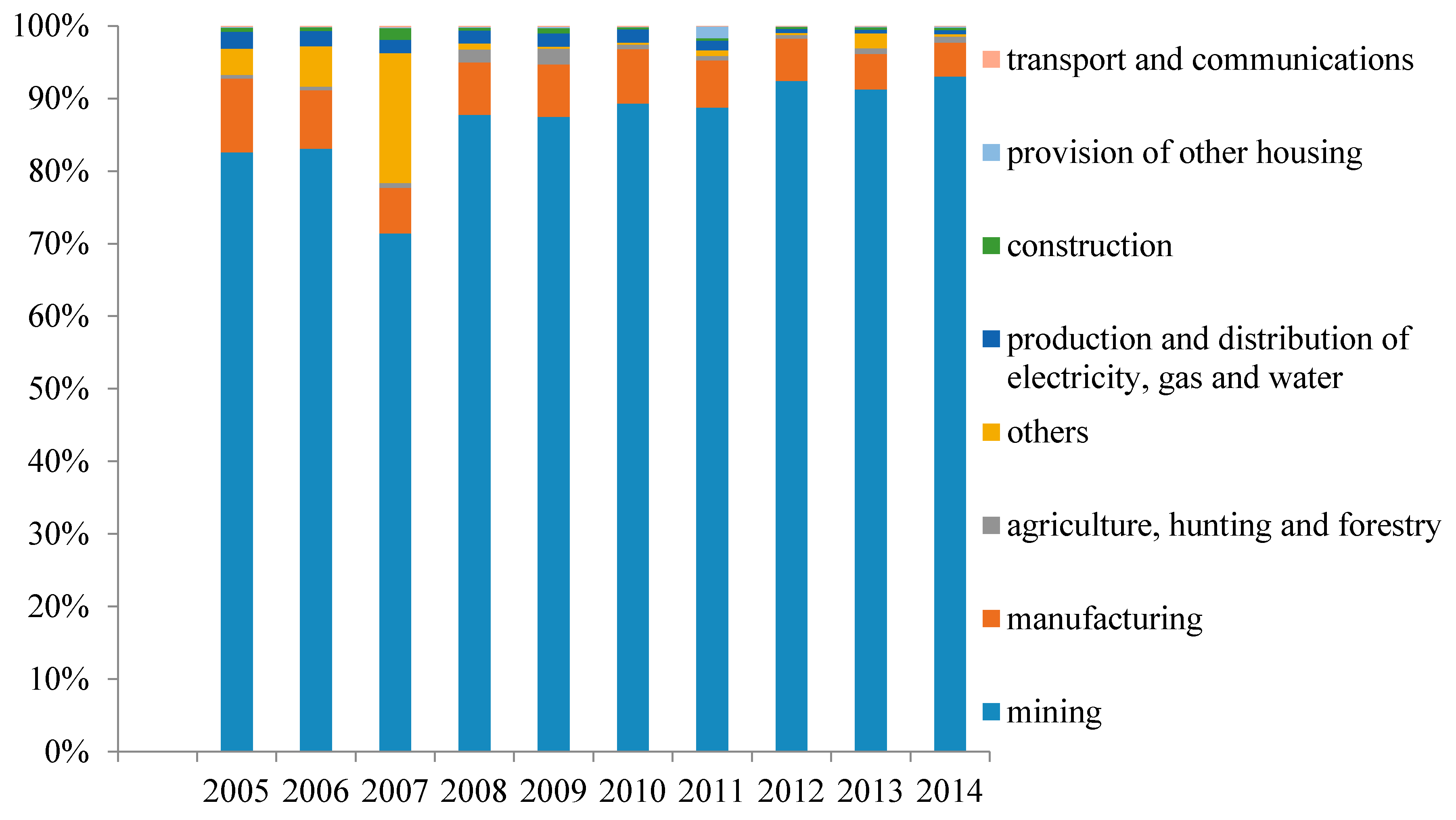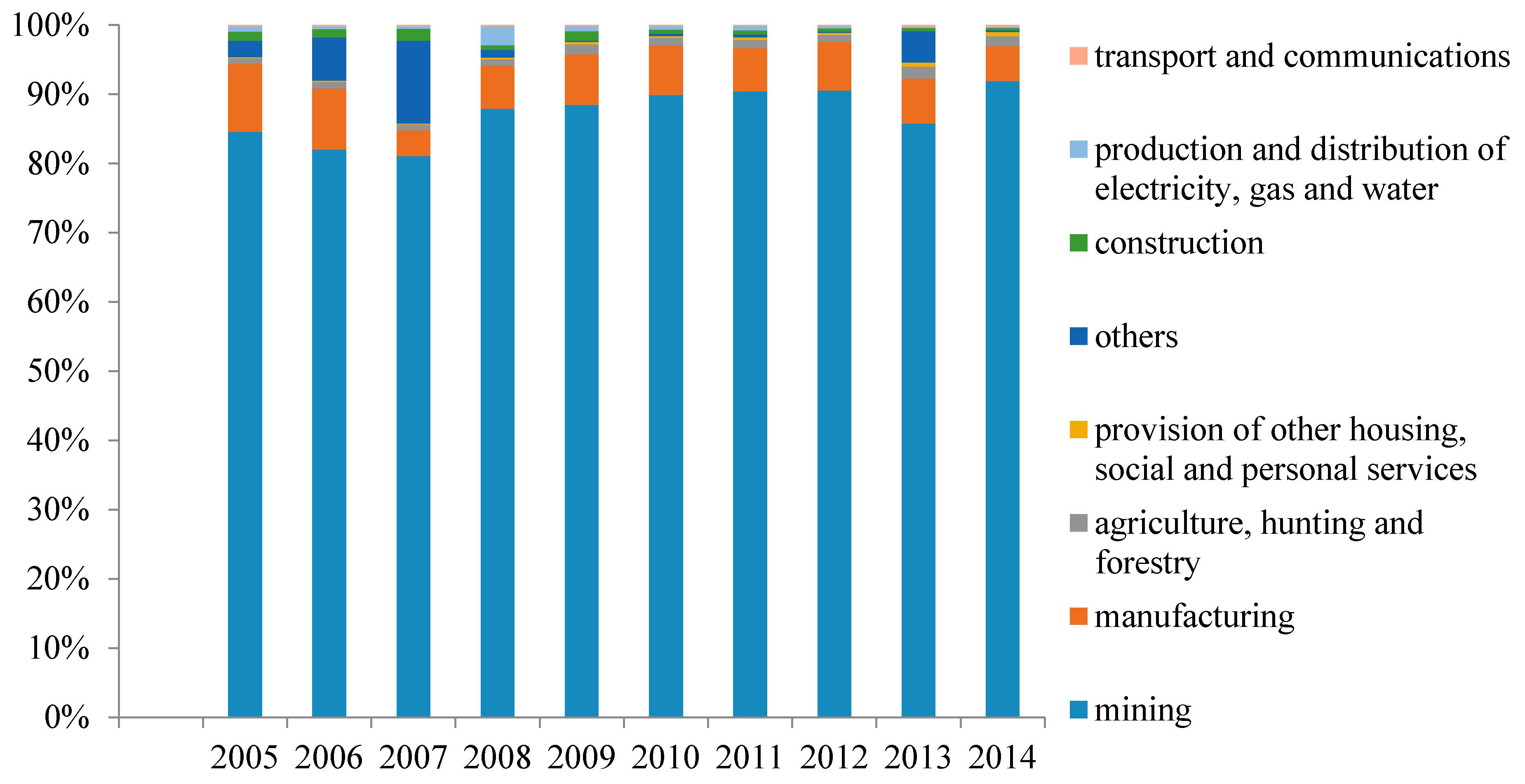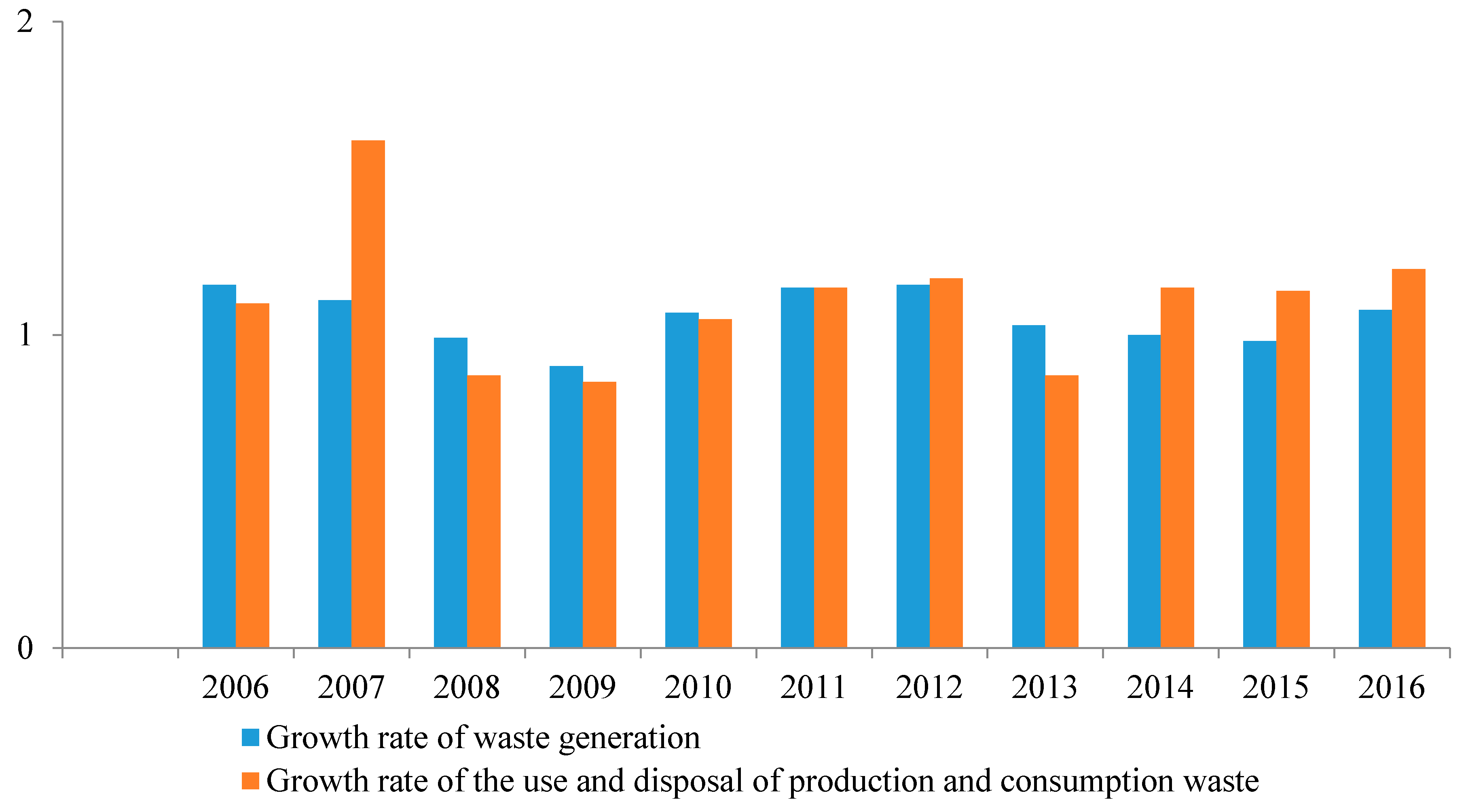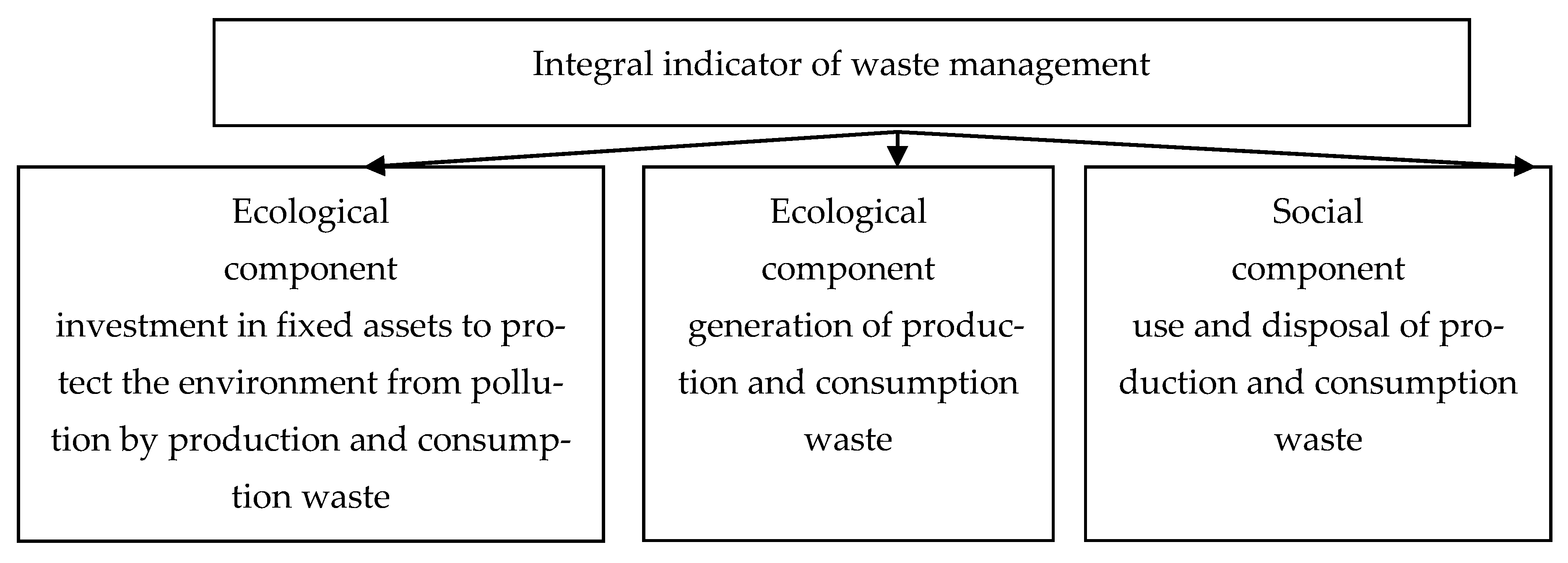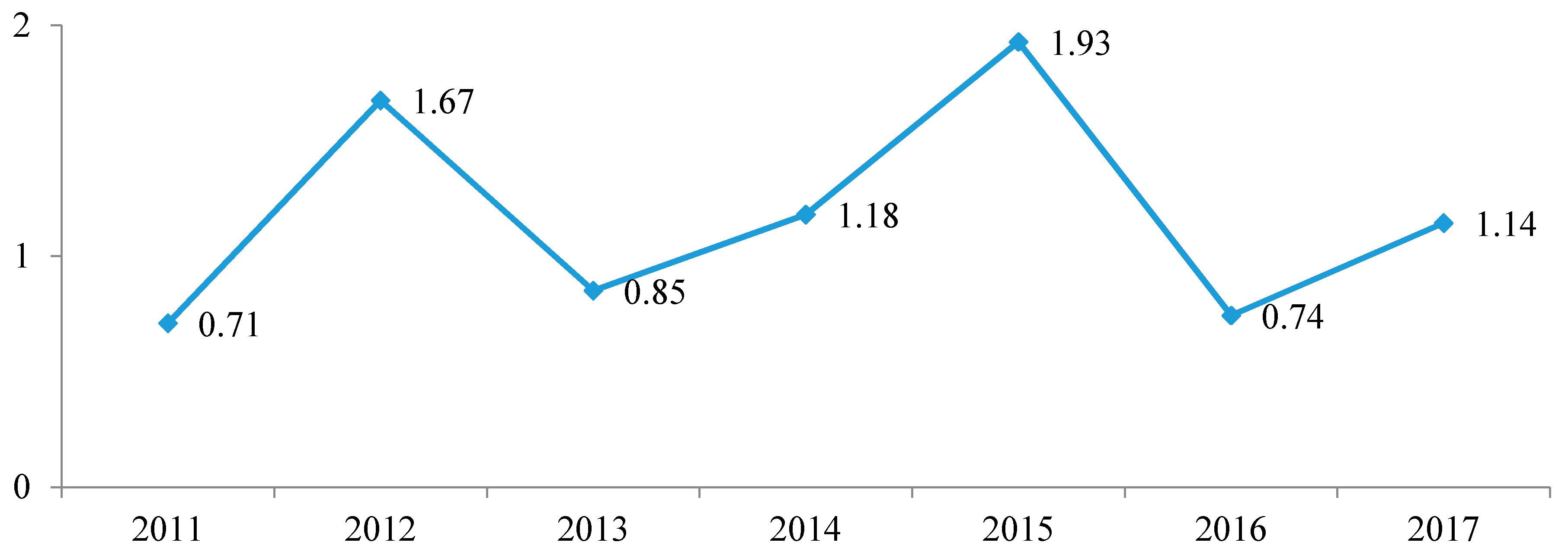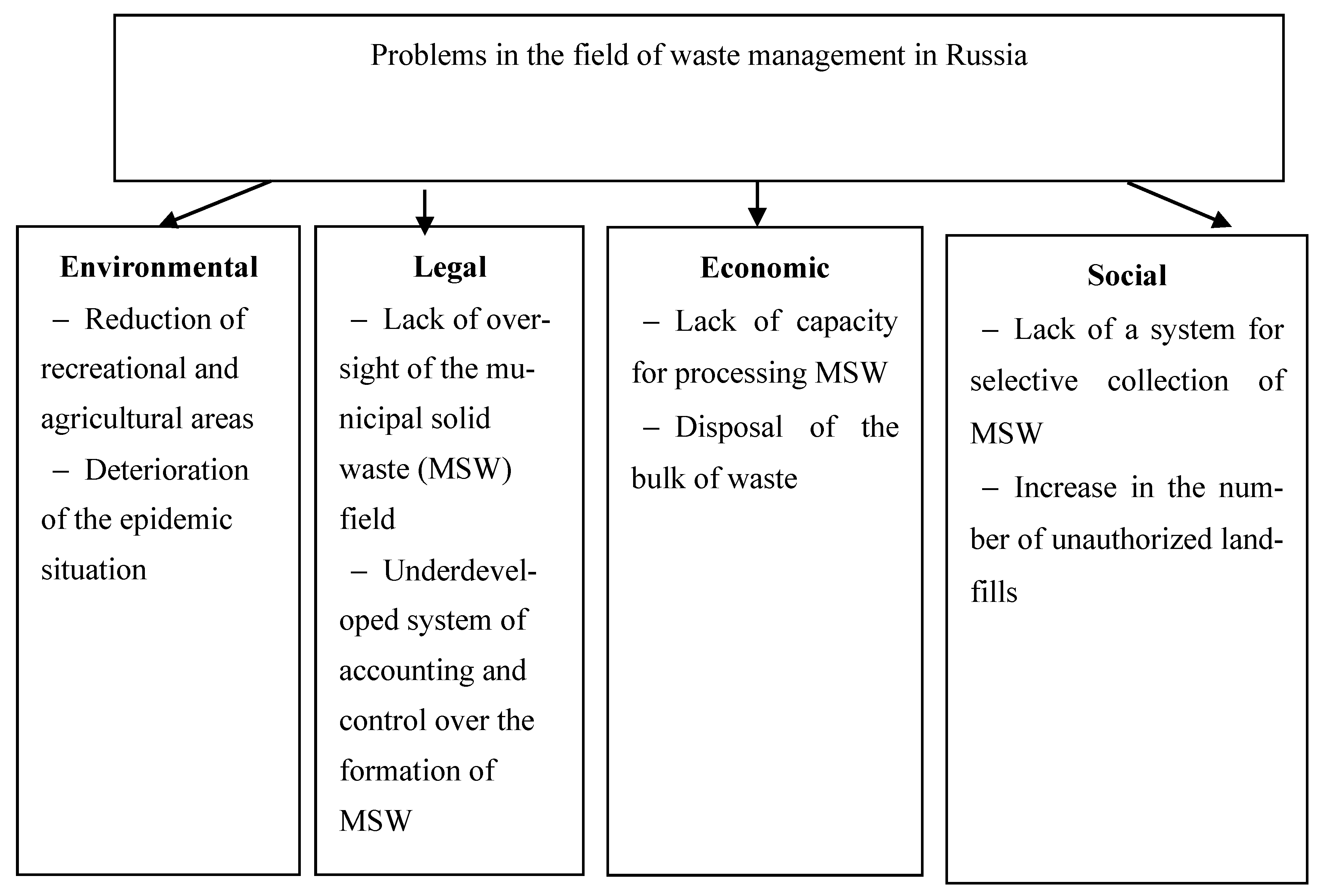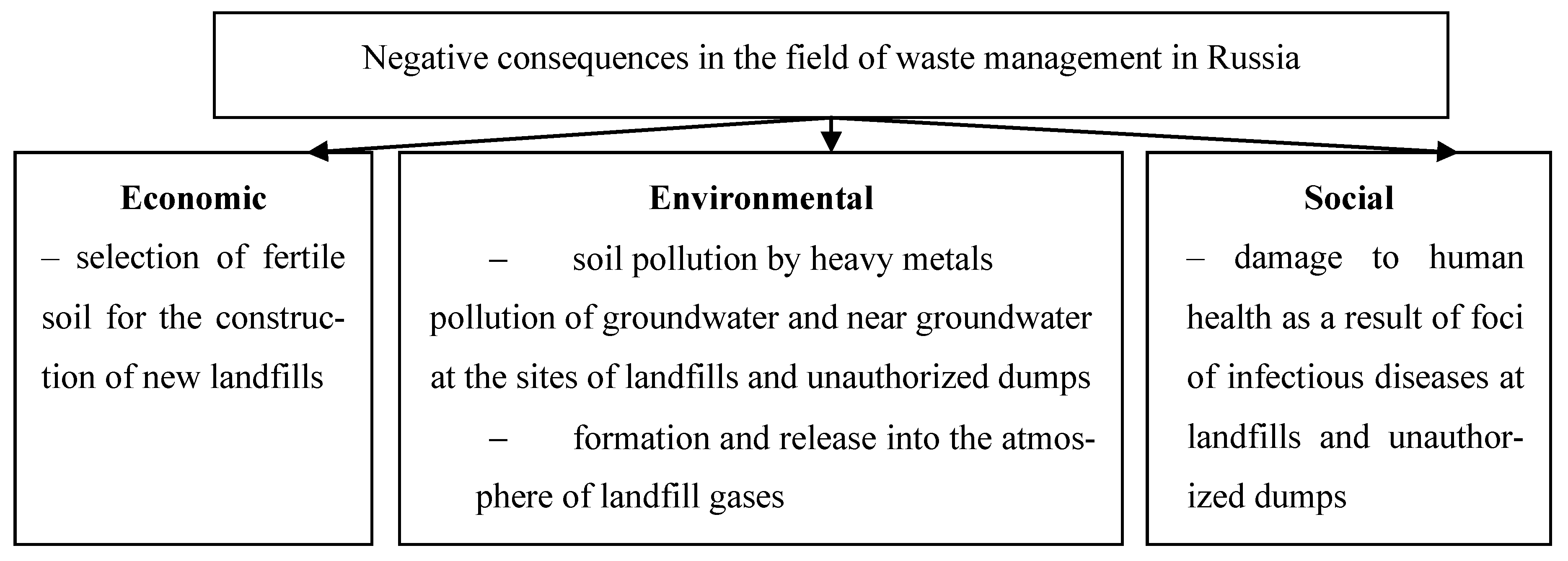2. Theoretical Framework and Literature Review
Waste generation and use is a complex problem with a number of diverse consequences. To develop a method for sustainable waste management, it is necessary to understand which components (subject areas) it should contain, what will serve as the assessment indicator (the final result of the assessment), and which methods and tools should be used to determine it.
The global practice of waste management is analyzed in three main directions (
Figure 2).
First, waste management issues are an element of the concept of sustainable development, the state of which determines the achievement of many goals of the concept [
5]. Concurrently, researchers analyze the key characteristics of various models of waste management and the possibilities these models present from the standpoint of sustainable waste management.
Morrissey A.J. and Browne J. found that, although many waste management models recognize the need to take into account environmental, economic, and social aspects, none of the models considered by the authors included all three aspects together when applying these models [
6]. None of them considered the intergenerational effects of the proposed strategies.
Grönlund S.E., by exploring indicators and methods for assessing the sustainability of wastewater sludge management, proved the need to use an integrated approach to reduce the negative impact of waste on the environment [
7].
The works of other authors are aimed at developing the models and methods of waste management themselves. Yakubu Y. and Zhou J. have proposed a new approach to quantifying municipal solid waste management based on the analytical hierarchy process [
8]. Equations developed by the authors of the model for the hierarchy of municipal solid waste, when used correctly, support the sustainable management of municipal solid waste.
Asefi H. and Lim S. considered multidimensional approaches to modeling integrated management of municipal solid waste, aimed at satisfying sustainability requirements in the design of the system, taking into account economic, environmental, and social factors [
9]. They developed a model to minimize fixed costs and transport costs and maximize system stability.
Martinez-Hernandez E., Leung Pah Hang MY, Leach M. and Yang A. proposed conceptual characteristics and a mathematical model of a local production system with techno-ecological interactions to support symbiosis between the industrial system and the ecosystem to create a sustainable techno-ecological system [
10].
Costi P., Minciardi R., Robba M., Rovatti M., and Sacile R. also proposed an environmentally sustainable decision-making model for municipal solid waste management based on non-linear optimization [
11]. The objective function of the model takes into account various economic costs and technical, regulatory, and environmental problems.
The focus of the study is a multi-purpose model for the processing of municipal solid waste that meets the goals of sustainable development [
12]. To achieve sustainable development, three of its dimensions are included in the objective function of the model. The function of the economic goal maximizes the profit of the system. The environmental protection objective minimizes emissions of carbon dioxide (CO
2), sulfur oxide (SO
2), nitrogen oxides (NOx), and heavy metals. The social goal function attempts to maximize the social impact of the network.
Hoang G. M., Fujiwara T., Pham Phu T. S., and Nguyen L. D. have developed a sustainable solid waste management system using a multi-purpose decision-making model which is based on the method of ensuring maximum social acceptability [
13]. Economic and environmental benefits, including minimizing landfills and polluting emissions, were the goals of the waste management system.
Kozyr N.S., Petrovskaya N.E., and Zazimko V.L., in their research, note that the main goals of waste management are “to reduce pressure on the environment, increase human health, rational use of natural resources, and promote the viability of ecological systems” [
14].
It should be emphasized that the considered works do not consider models of sustainable waste management at the macro level from the standpoint of compliance with the economic, environmental, and social components of the concept of sustainable development within the framework of the state policy. Although, of course, the models of these researchers are of undoubted interest for waste management at the level of individual settlement and enterprises. Thus, there is a research gap on the development of models for diagnosing the situation of sustainable/non-sustainable waste management at the country level as a whole, which is a result of legislative initiatives and their final implementation in the form of macroeconomic indicators.
Second, waste management issues are related to the concept of a Circular Economy and are considered in its framework. Merli R., Preziosi M., and Acampora A. conducted a systematic review of the literature on various aspects of the circular economy [
15]. They found that studies on the Circular Economy are predominantly concentrated in China and Europe. This is explained by the state policies implemented there.
Veleva V., Bodkin G., and Todorova S., in studying the problems of waste generation, substantiated the need for a better measurement of education and the involvement of employees in the circular economy [
16]. The authors found that when companies set the goal of “zero waste to landfill,” they focus not on preventing the generation of waste, but on diverting the resulting waste from ending up in the landfill. Consequently, they primarily focus on recycling and waste management methods to reduce waste, rather than reducing waste generation.
Caldera H.T.S., Desha C., and Dawes L., when exploring the relationship between lean thinking and sustainable and responsible business practices, proved the need to complement the lean manufacturing paradigm with a green paradigm [
17]. Resulting from their synergistic effect, the economic and environmental performance of the organization will improve significantly, including reduced waste and reduced emissions.
The state policies implemented in individual countries determine the relevance of the study of waste generation and use within the framework of the Circular Economy. However, the subject area of research includes individual environmental and economic aspects, without implying the creation of an integral indicator for diagnosing a sustainable waste management situation, while taking into account the three components of sustainable development—social, economic, and environmental. The development of an integrated indicator based on the social, economic, and environmental components is a poorly researched area.
Third, waste problems are considered in the framework of the analysis of the problems of various regions and sectors of the economy, including smart cities. Edalatpour M.A., Al-e-hashem S.M.J.M., Karimi B., and Bahli B., using the example of Tehran, investigated a new sustainable model of waste management in megacities [
18]. The authors proposed waste management with a random rate of waste generation, which takes into account various possibilities for waste disposal, recycling, and reuse processes.
Ngoc U.N. and Schnitzer H. examined waste generation indicators, their sources and composition, as well as future development trends in Southeast Asia [
19].
Moreover, Sel Ç., Soysal M., and Çimen M. developed a stochastic model for the catering industry and proved the potential advantages of outsourcing to reduce overall costs and reduce waste [
20].
Yadav V., Bhurjee A.K., Karmakar S., and Dikshit A.K. developed a model for selecting the location of an object of a solid waste management system under conditions of uncertain rates of waste generation, costs of facility operation, transportation costs, and revenues [
21].
Liu Y., Kong F., and Santibanez Gonzalez E.D.R. analyzed data on landfills, waste management, and environmental safety in England, including the reasons for illegal dumping based on panel data in England [
22].
During their study, Boltakova N.V., Faseeva G.R., Kabirov R.R., Nafikov R.M., and Zakharov Y.A. examined the possibilities of using various inorganic industrial wastes for the production of building ceramics, as well as Russian developments in the field of environmental management in the ceramic industry [
23].
Starostina V., Damgaard A., Eriksen M.K., and Christensen T.H. reviewed waste management in the Irkutsk region of the Russian Federation [
24]. The authors found that the existing waste management system primarily includes landfill in an uncontrolled landfill without environmental measures, contributing to climate change, although a number of alternatives to this will provide a significant improvement in the environment.
Seen in the work of Zhang et al. [
25], the authors note that it is necessary to create a new type of managerial thinking aimed at the transition to a “zero-waste circular economy.” They note that this is especially true for China, due to the specifics of the national economy.
Thus, we can conclude that the regional problems of waste management are considered by researchers from the perspective of finding tools to solve them. These solutions, in turn, are in the field of using modern management tools, including outsourcing, stochastic logistic models, etc. for specific companies, industries, and regions. The practical use of these models depends on management targets. Sustainable waste management models will only be effective and efficient when the criteria for the concept of sustainable development are used along with indicators of economic efficiency when making strategic and tactical decisions. A necessary element for this is the creation of models for diagnosing the waste management situation, taking into account changes in the social, economic, and environmental components. Such models are not sufficiently methodically developed.
Overall, a review of the problems that exist within the analyzed waste management research groups show the following. First, the research gap consists of practical models for diagnosing the situation with waste management at the macro level, which, in the form of a single integral indicator, take into account the simultaneous influence of social, economic, and environmental factors. Second, the management of sustainable waste management should be based on dynamic measurements of their changes (growth/growth rates). Third, waste management models should reflect the state of legislative and executive initiatives through specific macroeconomic indicators and allow for identifying the causes of sustainable/non-sustainable waste management.
5. Discussion
While solid waste is an environmental issue of great concern to residents of developed countries, garbage is still a governmental problem in Russia. The problem of handling municipal solid waste (MSW) in Russia was not included in the list of the most important federal programs and remained outside the scope of interests of the environmental community. Its priorities so far remain in the development of “low-waste” and “non-waste” technologies and end at the stage of turning raw materials into finished products. This break in the chain is the cause of the greatest damage to the environment. The most effective environmental management levers that can ensure the implementation of the concept of sustainable development are in this gap.
An increase in the amount of waste, an increase in its negative impact on the environment, a shortage of resources (containers, garbage trucks, equipped container sites, modern technologically equipped landfills), increased costs associated with the collection of waste, disposal at landfills, and subsequent industrial processing are problems of treatment for waste in Russia. The main problems of waste management in Russia are shown in
Figure 19.
Since the unresolved problems of industrial and household waste have economic, social, and organizational aspects, they threaten the implementation of the concept of sustainable development in Russia. Sustainable waste management limits the environmental impact of MSW, both in the short and long term. The negative effects of non-sustainable waste management are presented in
Figure 20.
The main objectives of waste management in Russia are the following. First, the maximum use of the selective collection of municipal solid waste to obtain secondary resources and reduce the amount of neutralized waste. Second, the optimal operation of landfills, taking into account subsequent land reclamation. Third, the construction of highly mechanized integrated waste processing enterprises.
Unfortunately, it is necessary to state the absence of environmental responsibility for most Russian manufacturers and the general low level of production culture due to a number of socio-economic, political, and legal factors. Given the energy and raw materials orientation of the development of the Russian economy, the problem of sustainable waste management, as a governmental problem, will be relevant in the near future.
The situation of waste management in Russia, as a country with a world level of significant environmental problems with a large number of raw materials and resource processing industries, requires correction. Mining and manufacturing together account for nearly one third of the gross value added structure of the Russian Federation over the past years. Every year in Russia there is an increase in both absolute and relative terms of the generation of both general and hazardous waste, which must be disposed of without fail.
Mining generates the most waste. Since 2012, this industry accounts for more than 90% of the waste in the Russian Federation. Regarding the Russian Federation, a MSW neutralization system has been developed based on the disposal of about 98% of waste at landfills and unorganized dumps. Since 2015, a favorable trend has been observed—the amount of used and neutralized waste exceeds the amount of waste disposed of in landfills.
We conducted a dynamic analysis of the integrated indicator of waste management in the Russian Federation from 2012 to 2017. We identified non-sustainable waste management in 2011, 2013, and 2016. During 2012, 2014, 2015, and 2017, waste management was sustainable. The change in the growth rate of investments in environmental protection from waste pollution played a decisive role in changing the integral indicator.
Generally, we can say that a change in the economic component determines the sustainability (or non-sustainability) of waste management in the Russian Federation. Furthermore, responsible production and the responsible use of production and consumption waste is an untapped area of potential for sustainable waste management.
Despite the fact that, each year, Russia occupies an increasingly high position in international competitiveness ratings, there are a number of reasons which prevent us from diagnosing the sustainable development of the Russian economy. Concerning the field of economics, these include the low level of economic added value, exploitation of natural resources, and export of energy resources. Regarding the social sphere, these include a high level of social stratification of society. Considering the environmental sphere, these include a high level of negative anthropogenic pressure on industrial and domestic waste on the environment.
It is necessary to emphasize the lack of environmental responsibility for most Russian manufacturers and the general low level of production culture due to a set of socio-economic and political-legal factors. The unsolved problems of industrial and household waste have economic, social, and organizational aspects which threaten the implementation of the concept of sustainable development in Russia. Our developed indicator can become the basis for managerial decisions to develop a sustainable model of waste management, especially in countries with a similar structure of gross value added.
6. Conclusions
New approaches for identifying the type of waste management (sustainable or unsustainable), including the stages of assessment, diagnosis, and forecasting of the integrative indicator complying with the principles of sustainable development have been developed in this article.
Considering the peculiarities of the Russian statistical system, an integrated indicator of waste management has been developed. This indicator is a mixed factor model. It consists of three factors that characterize the economic, environmental, and social components. The economic component is the rate of investment in fixed assets to protect the environment from pollution by production and consumption waste; it characterizes compliance with the principles of a circular and green economy. The environmental component is the rate of production and consumption waste generation; it characterizes compliance with the principles of non-waste production. The social component is the rate of use and disposal of production and consumption waste; it characterizes compliance with the principles of responsible production and consumption.
Analysis of sustainable waste management includes three stages—assessment, diagnostics, and forecasting changes in the integral indicator of waste management. This indicator allows us to determine if a waste management system is sustainable or non-sustainable. A deterministic factor model based on the method of chain substitutions is proposed to diagnose the integral indicator of waste management and measure the influence of individual factors on its change.
Our developed indicator can become the basis for managerial decisions to develop a sustainable model of waste management, as it allows identification and correction of imbalances between environmental, social, and economic factors in waste management situations.
Additionally, a key feature of this approach is its dynamic nature. To determine the integral indicator of sustainable/unstable waste management, the rates of factors changing—namely the waste generation, the waste management, and its disposal—the investments in environmental protection from waste pollution have been taken into account.
The proposed approach can become the basis for managerial decisions in the economic, environmental, and social spheres to develop a sustainable model of waste management. The developed indicator and approach can be used in other countries, especially in countries with a similar gross value added structure.






